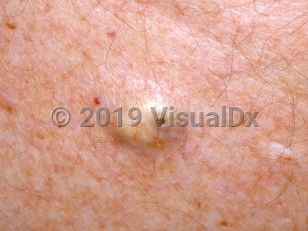Epidermoid cyst in Adult
See also in: Anogenital,Hair and ScalpAlerts and Notices
Important News & Links
Synopsis

An epidermoid cyst, also known as an epidermal inclusion cyst, is a semi-solid cyst. The cyst wall is stratified squamous epithelium, and the contents consist of macerated keratin and lipid-rich debris. The epidermoid cyst is a common lesion that can arise on the face, trunk, extremities, in the mouth, or on the genitals at any age. They are more common in men. Several etiologic factors have been implicated in the formation of epidermoid cysts, including traumatic or iatrogenic implantation of epidermal elements, sequestration of epidermal rests, occlusion of the eccrine duct or pilosebaceous unit, and human papillomavirus (HPV) infection. Epidermoid cysts are a feature of several hereditary syndromes, such as Gardner syndrome, pachyonychia congenita, and the basal cell nevus syndrome. It is rare to see an epidermoid cyst in a pre-pubertal patient; in such cases, other diagnoses should be carefully considered.
Epidermoid cysts are benign and usually asymptomatic, but they may be painful if ruptured or infected. Rarely, malignancies such as basal cell carcinoma, squamous cell carcinoma, and mycosis fungoides have developed within these cysts.
Epidermoid cysts are benign and usually asymptomatic, but they may be painful if ruptured or infected. Rarely, malignancies such as basal cell carcinoma, squamous cell carcinoma, and mycosis fungoides have developed within these cysts.
Codes
ICD10CM:
L72.0 – Epidermal cyst
SNOMEDCT:
419893006 – Epidermoid cyst
L72.0 – Epidermal cyst
SNOMEDCT:
419893006 – Epidermoid cyst
Look For
Subscription Required
Diagnostic Pearls
Subscription Required
Differential Diagnosis & Pitfalls

To perform a comparison, select diagnoses from the classic differential
Subscription Required
Best Tests
Subscription Required
Management Pearls
Subscription Required
Therapy
Subscription Required
References
Subscription Required
Last Reviewed:05/08/2017
Last Updated:06/20/2017
Last Updated:06/20/2017
 Patient Information for Epidermoid cyst in Adult
Patient Information for Epidermoid cyst in Adult
Premium Feature
VisualDx Patient Handouts
Available in the Elite package
- Improve treatment compliance
- Reduce after-hours questions
- Increase patient engagement and satisfaction
- Written in clear, easy-to-understand language. No confusing jargon.
- Available in English and Spanish
- Print out or email directly to your patient
Upgrade Today

Epidermoid cyst in Adult
See also in: Anogenital,Hair and Scalp

